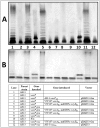The Polymerization of Aeromonas hydrophila AH-3 O-Antigen LPS: Concerted Action of WecP and Wzy
- PMID: 26161781
- PMCID: PMC4498686
- DOI: 10.1371/journal.pone.0131905
The Polymerization of Aeromonas hydrophila AH-3 O-Antigen LPS: Concerted Action of WecP and Wzy
Abstract
The repeat units of heteropolymeric O antigen are synthesized at the cytosolic side of the inner bacterial membrane via the Wzx/Wzy-dependent assembly pathway. After being translocated across the membrane by Wzx, each repeat unit is polymerized by Wzy to form a glycan chain. In this study, we demonstrate the need of the corresponding enzyme transferring the initial HexNAc to undecaprenol phosphate (lipid carrier), together with the corresponding O-antigen polymerase (Wzy), to produce the Aeromonas hydrophila O:34-antigen. We suggest, the concerted action of WecA or P enzyme (UDP-HexNAc: polyprenol-P HexNAc-1-P transferase) and Wzy is involved in the mechanism responsible for the A. hydrophila O-antigen polymerization.
Conflict of interest statement
Figures






Similar articles
-
Repeat-Unit Elongations To Produce Bacterial Complex Long Polysaccharide Chains, an O-Antigen Perspective.EcoSal Plus. 2023 Dec 12;11(1):eesp00202022. doi: 10.1128/ecosalplus.esp-0020-2022. Epub 2023 Jan 9. EcoSal Plus. 2023. PMID: 36622162 Free PMC article. Review.
-
The first sugar of the repeat units is essential for the Wzy polymerase activity and elongation of the O-antigen lipopolysaccharide.Future Microbiol. 2016 Jul;11:903-18. doi: 10.2217/fmb-2015-0028. Epub 2016 Jun 30. Future Microbiol. 2016. PMID: 27357519
-
A UDP-HexNAc:polyprenol-P GalNAc-1-P transferase (WecP) representing a new subgroup of the enzyme family.J Bacteriol. 2011 Apr;193(8):1943-52. doi: 10.1128/JB.01441-10. Epub 2011 Feb 18. J Bacteriol. 2011. PMID: 21335454 Free PMC article.
-
The UDP N-acetylgalactosamine 4-epimerase gene is essential for mesophilic Aeromonas hydrophila serotype O34 virulence.Infect Immun. 2006 Jan;74(1):537-48. doi: 10.1128/IAI.74.1.537-548.2006. Infect Immun. 2006. PMID: 16369010 Free PMC article.
-
Synthesis of bacterial polysaccharides via the Wzx/Wzy-dependent pathway.Can J Microbiol. 2014 Nov;60(11):697-716. doi: 10.1139/cjm-2014-0595. Epub 2014 Sep 16. Can J Microbiol. 2014. PMID: 25358682 Review.
Cited by
-
Surface Glucan Structures in Aeromonas spp.Mar Drugs. 2021 Nov 22;19(11):649. doi: 10.3390/md19110649. Mar Drugs. 2021. PMID: 34822520 Free PMC article. Review.
-
Repeat-Unit Elongations To Produce Bacterial Complex Long Polysaccharide Chains, an O-Antigen Perspective.EcoSal Plus. 2023 Dec 12;11(1):eesp00202022. doi: 10.1128/ecosalplus.esp-0020-2022. Epub 2023 Jan 9. EcoSal Plus. 2023. PMID: 36622162 Free PMC article. Review.
-
LPS-Induced Mortality in Zebrafish: Preliminary Characterisation of Common Fish Pathogens.Microorganisms. 2023 Aug 31;11(9):2205. doi: 10.3390/microorganisms11092205. Microorganisms. 2023. PMID: 37764049 Free PMC article.
-
Identifying genetic diversity of O antigens in Aeromonas hydrophila for molecular serotype detection.PLoS One. 2018 Sep 5;13(9):e0203445. doi: 10.1371/journal.pone.0203445. eCollection 2018. PLoS One. 2018. PMID: 30183757 Free PMC article.
References
-
- Nikaido H (1996). In Escherichia coli and Salmonella: Cellular and Molecular Biology (Neidhardt FC, Curtiss R, Ingraham JL, Lin ECC, Low KB, Magasanik B, Reznikoff WS, Riley M, Schaechter M, Umbarger HE, eds.) pp.29–47, ASM Press, USA.
-
- Samuel G, Reeves P (2003). Biosynthesis of O-antigens: Genes and pathways involved in nucleotide sugar precursor synthesis and O-antigen assembly. Carbohydr. Res. 338: 2503–2519. - PubMed
-
- Hug I, Feldman MF (2011). Analogies and homologies in lipopolysaccharide and glycoprotein biosynthesis in bacteria. Glycobiol. 21: 138–151. - PubMed
Publication types
MeSH terms
Substances
LinkOut - more resources
Full Text Sources
Other Literature Sources

